Experimental Study on Proportion Optimization of Rock-like Materials Based on Genetic Algorithm Inversion
Abstract
:1. Introduction
2. Materials and Methods
2.1. Target Rocks and Macro-Parameters
2.2. Material and Proportioning Factors
2.3. Sample Preparation and Experimental Design
3. Results and Analyses
3.1. Orthogonal Test Results
3.2. Sensitivity ANOVA
3.3. Multiple Linear Regression Analysis
3.3.1. Model Construction
3.3.2. Conditional Decision
3.3.3. Analysis and Inspection
4. Optimization Model for Rock-Like Material Ratios
4.1. Optimization Models and Algorithms
4.2. Realization of Proportion Optimization Program
- Produce an initial population {x}0, and N individuals are randomly generated (taken as 100 in this paper).
- Evaluate the fitness of each individual in the group:
- ①
- Assume that k = 1.
- ②
- Judge the interval of each microscopic parameter in the kth individual {xk}0.
- ③
- Select the corresponding quantitative relationship to calculate the value of , , , , and .
- ④
- Calculate the fitness value of individual {xk}0 according to Equation (15).
- ⑤
- k = k + 1.
- ⑥
- If k ≤ N, continue the calculation. If k > N, exit the calculation as it is complete.
- Select excellent individuals and deposit them in the mating pool.
- Use the crossover and mutation operators to form the population {x}i for the next generation in the mating pool.
- Repeat the steps in (2) to evaluate the fitness of individuals in the new population.
- If the end condition is met, stop and obtain the optimal solution; otherwise, go to step (3) to continue the calculation.
4.3. Test of Inversion Optimization Effect
5. Conclusions
- (1)
- According to the sensitivity variance analysis, the ratio of water to gypsum has a very significant effect on σc, σt, τf, E, ν and c. The content of iron powder has a highly significant effect on σc, σt, τf and c, and it has a significant effect on ν and φ. The content of coarse sand has a significant effect on σc, E and c.
- (2)
- Except for φ, the multivariate linear regression model of other macro-mechanical parameters is highly significant. The fitting value of the regression model is similar to the curve shape of the orthogonal test results with a small error, which meets the test requirements of rock-like materials and can be used to predict the macro-mechanical parameters of rock-like materials in a certain range.
- (3)
- In the process of inverse proportion optimization based on the genetic algorithm, the correct selection of materials, the correct application of experimental design methods and the appropriate selection of optimization models and algorithms are the keys to achieve good proportion optimization results. Through this program, it is concluded that the optimum proportion of rock-like materials with the closest mechanical properties to gneiss granite is a water–gypsum ratio of 0.5325, iron powder content of 3.975% and coarse sand content of 15.967%.
Author Contributions
Funding
Institutional Review Board Statement
Informed Consent Statement
Data Availability Statement
Acknowledgments
Conflicts of Interest
References
- Fan, X.; Yang, Z.; Hong, M.; Yu, H.; Xie, Y. Stress distribution and failure mechanism around two different shapes of openings in fractured rock-like materials. J. Cent. South Univ. 2022, 29, 1916–1932. (In Chinese) [Google Scholar] [CrossRef]
- Wong, R.; Chau, K. Crack coalescence in a rock-like material containing two cracks. Int. J. Rock Mech. Min. Sci. 1998, 35, 147–164. [Google Scholar] [CrossRef]
- Asadizadeh, M.; Hossaini, M.F.; Moosavi, M.; Masoumi, H.; Ranjith, P.G. Mechanical characterisation of jointed rock-like material with non-persistent rough joints subjected to uniaxial compression. Eng. Geol. 2019, 260, 105224. [Google Scholar] [CrossRef]
- Shi, J.; Chen, Z.; Zheng, B. Experimental Research on Material and Mechanical Properties of Rock-Like Filling Materials in Disaster Prevention of Underground Engineering. Adv. Mater. Sci. Eng. 2021, 2021, 6691310. [Google Scholar] [CrossRef]
- Cui, J.; Hao, J.; Li, P.; Li, C.; Zhang, Y.; Wang, K. Proportioning optimization of transparent rock-like specimens with different fracture structures. Sci. Rep. 2024, 14, 9404. [Google Scholar] [CrossRef] [PubMed]
- Stimpson, B. Modelling materials for engineering rock mechanics. Int. J. Rock Mech. Min. Sci. Geomech. Abstr. 1970, 7, 77–121. [Google Scholar] [CrossRef]
- Nowamooz, A.; Radilla, G.; Fourar, M. Non-Darcian two-phase flow in a transparent replica of a rough-walled rock fracture. Water Resour. Res. 2009, 45, W07406. [Google Scholar] [CrossRef]
- Tariq, K.A.; Maki, T. Mechanical behaviour of cement-treated sand. Constr. Build. Mater. 2014, 58, 54–63. [Google Scholar] [CrossRef]
- Cheng, W.; Sun, L.; Wang, G.; Du, W.; Qu, H. Experimental research on coal seam similar material proportion and its application. Int. J. Min. Sci. Technol. 2016, 26, 913–918. [Google Scholar] [CrossRef]
- Shi, X.M.; Liu, B.G.; Xiang, Y.Y.; Qi, Y. A Method for Selecting Similar Materials for Rocks in Scaled Physical Modeling Tests. J. Min. Sci. 2018, 54, 938–948. [Google Scholar] [CrossRef]
- Zhuang, X.; Chun, J.; Zhu, H. A comparative study on unfilled and filled crack propagation for rock-like brittle material. Theor. Appl. Fract. Mech. 2014, 72, 110–120. [Google Scholar] [CrossRef]
- Zhou, X.P.; Cheng, H.; Feng, Y.F. An Experimental Study of Crack Coalescence Behaviour in Rock-Like Materials Containing Multiple Flaws Under Uniaxial Compression. Rock Mech. Rock Eng. 2014, 47, 1961–1986. [Google Scholar] [CrossRef]
- Cao, R.H.; Cao, P.; Lin, H.; Pu, C.Z.; Ou, K. Mechanical Behavior of Brittle Rock-Like Specimens with Pre-existing Fissures Under Uniaxial Loading: Experimental Studies and Particle Mechanics Approach. Rock Mech. Rock Eng. 2016, 49, 763–783. [Google Scholar] [CrossRef]
- Tang, Q.; Xie, W.; Jing, S.; Wang, X.; Su, Z. Experimental and Numerical Investigation on the Mechanical Behavior of Rock-Like Material with Complex Discrete Joints. Rock Mech. Rock Eng. 2024, 57, 4493–4511. [Google Scholar] [CrossRef]
- Chong, B.W.; Othman, R.; Putra Jaya, R.; Mohd Hasan, M.R.; Sandu, A.V.; Nabiałek, M.; Jeż, B.; Pietrusiewicz, P.; Kwiatkowski, D.; Postawa, P.; et al. Design of Experiment on Concrete Mechanical Properties Prediction: A Critical Review. Materials 2021, 14, 1866. [Google Scholar] [CrossRef]
- Ghassemi, P.; Toufigh, V. Durability of epoxy polymer and ordinary cement concrete in aggressive environments. Constr. Build. Mater. 2020, 234, 117887. [Google Scholar] [CrossRef]
- Sharifi, E.; Sadjadi, S.J.; Aliha, M.R.M.; Moniri, A. Optimization of high-strength self-consolidating concrete mix design using an improved Taguchi optimization method. Constr. Build. Mater. 2020, 236, 117547. [Google Scholar] [CrossRef]
- Habibi, A.; Ghomashi, J. Development of an optimum mix design method for self-compacting concrete based on experimental results. Constr. Build. Mater. 2018, 168, 113–123. [Google Scholar] [CrossRef]
- Abhilash, M.; Jhanjhari, S.; Parthiban, P.; Karthikeyan, J. Axial behaviour of semi-lightweight aggregate concrete-filled steel tube columns—A DOE approach. J. Constr. Steel Res. 2019, 162, 105614. [Google Scholar] [CrossRef]
- Ju, H.; Yerzhanov, M.; Serik, A.; Lee, D.; Kim, J.R. Statistical and Reliability Study on Shear Strength of Recycled Coarse Aggregate Reinforced Concrete Beams. Materials 2021, 14, 3321. [Google Scholar] [CrossRef]
- Le, J.; Bažant, P.Z. Failure Probability of Concrete Specimens of Uncertain Mean Strength in Large Database. J. Eng. Mech. 2020, 146, 04020039. [Google Scholar] [CrossRef]
- Wang, X. Optimal mix design of low-CO2 blended concrete with limestone powder. Constr. Build. Mater. 2020, 263, 121006. [Google Scholar] [CrossRef]
- Wang, X.Y. Design of low-cost and low-CO2 air-entrained fly ash-blended concrete considering carbonation and frost durability. J. Clean. Prod. 2020, 272, 122675. [Google Scholar] [CrossRef]
- Gu, H.; Sun, J.; Zhang, J.; Xu, Y.; Li, B.; Wu, W. Effect of material ratio on the performances in 3D cement printing and its optimization. AIP Adv. 2020, 10, 125012. [Google Scholar] [CrossRef]
- Song, Y.; Liu, B.G.; Liu, H.; Sun, J.L.; Yu, M.Y.; Ren, D.R. Orthogonal experimental study on rock-like material ratio based on deformation and brittleness characteristics. Geotechnics 2020, 41, 2675–2684. (In Chinese) [Google Scholar]
- Chen, D.; Cao, T.; Yang, K.; Chen, R.; Li, C.; Qin, R. Study on the Optimization of Proportion of Fly Ash-Based Solid Waste Filling Material with Low Cost and High Reliability. Sustainability 2022, 14, 8530. [Google Scholar] [CrossRef]
- Wu, T.; Zhao, H.; Xu, Q.; Zhao, Y. Optimal analysis of material ratio for artificial rock by 3D printing technique. Geomech. Geoengin. 2020, 17, 260–268. [Google Scholar] [CrossRef]
- Hao, C.; Feng, G.; Wang, P. Proportion optimization of grouting materials for roadways with soft surrounding mass. Int. J. Green Energy 2021, 18, 203–218. [Google Scholar] [CrossRef]
- Zhao, Z.; Liu, Y.; Lu, Y.; Ji, C.; Lin, C.; Yao, L.; Pu, Z.; de Brito, J. Prediction of properties of recycled aggregate concrete using machine learning models: A critical review. J. Build. Eng. 2024, 90, 109516. [Google Scholar] [CrossRef]
- Chaabene, W.B.; Flah, M.; Nehdi, M.L. Machine learning prediction of mechanical properties of concrete: Critical review. Constr. Build. Mater. 2020, 260, 119889. [Google Scholar] [CrossRef]
- Chen, H.; Deng, T.; Du, T.; Chen, B.; Skibniewski, M.J.; Zhang, L. An RF and LSSVM–NSGA-II method for the multi-objective optimization of high-performance concrete durability. Cem. Concr. Compos. 2022, 129, 104446. [Google Scholar] [CrossRef]
- Beji, H.; Messager, T.; Kanit, T. Equivalent Morphology Concept in Composite Materials Using Machine Learning and Genetic Algorithm Coupling. J. Compos. Sci. 2024, 8, 297. [Google Scholar] [CrossRef]
- Fan, D.; Rui, Y.; Liu, K.; Tan, J.; Shui, Z.; Wu, C.; Wang, S.; Guan, Z.; Hu, Z.; Su, Q. Optimized design of steel fibres reinforced ultra-high performance concrete (UHPC) composites: Towards to dense structure and efficient fibre application. Constr. Build. Mater. 2020, 273, 121698. [Google Scholar]
- Salami, B.A.; Iqbal, M.; Abdulraheem, A.; Jalal, F.E.; Alimi, W.; Jamal, A.; Tafsirojjaman, T.; Liu, Y.; Bardhan, A. Estimating compressive strength of lightweight foamed concrete using neural, genetic and ensemble machine learning approaches. Cem. Concr. Compos. 2022, 133, 104721. [Google Scholar] [CrossRef]
- Sun, H.; Burton, H.; Huang, H. Machine Learning Applications for Building Structural Design and Performance Assessment: State-of-the-Art Review. J. Build. Eng. 2020, 33, 101816. [Google Scholar] [CrossRef]
- Zavala, G.R.; Nebro, A.J.; Luna, F.; Coello Coello, C.A. A survey of multi-objective metaheuristics applied to structural optimization. Struct. Multidiscip. Optim. 2014, 49, 537–558. [Google Scholar] [CrossRef]
- Holland, J.H. Adaptation in Natural and Artificial Systems: An Introductory Analysis with Applications to Biology, Control, and Artificial Intelligence; The MIT Press: Cambridge, MA, USA, 1992. [Google Scholar] [CrossRef]
- Dvoršek, N.; Stopeinig, I.; Klančnik, S. Optimization of Chaboche Material Parameters with a Genetic Algorithm. Materials 2023, 16, 1821. [Google Scholar] [CrossRef]
- Lu, L.; Kong, X.; Dong, Y.; Zou, D.; Zhou, Y. Similarity Relationship for Brittle Failure Dynamic Model Experiment and Its Application to a Concrete Dam Subjected to Explosive Load. Int. J. Geomech. 2017, 17, 04017027. [Google Scholar] [CrossRef]
- Abedi, R.; Haber, R.B. Spacetime dimensional analysis and self-similar solutions of linear elastodynamics and cohesive dynamic fracture. Int. J. Solids Struct. 2011, 48, 2076–2087. [Google Scholar] [CrossRef]
- Liu, H.; Fu, L.; Jiao, Y.; Tao, J.; Wang, X. Short-Term Aging Effect on Properties of Sustainable Pavement Asphalts Modified by Waste Rubber and Diatomite. Sustainability 2017, 9, 996. [Google Scholar] [CrossRef]
- Cong, P.; Chen, S.; Chen, H. Effects of diatomite on the properties of asphalt binder. Constr. Build. Mater. 2012, 30, 495–499. [Google Scholar] [CrossRef]
- Ko, T.Y.; Lee, S.S. Characteristics of Crack Growth in Rock-Like Materials under Monotonic and Cyclic Loading Conditions. Appl. Sci. 2020, 10, 719. [Google Scholar] [CrossRef]
- Lee, R. Statistical Design of Experiments for Screening and Optimization. Chem. Ing. Tech. 2019, 91, 191–200. [Google Scholar] [CrossRef]
- Chen, Y.; Ye, W.; Zhang, K. Strength of copolymer grouting material based on orthogonal experiment. J. Cent. South Univ. Technol. 2009, 16, 143–148. [Google Scholar] [CrossRef]
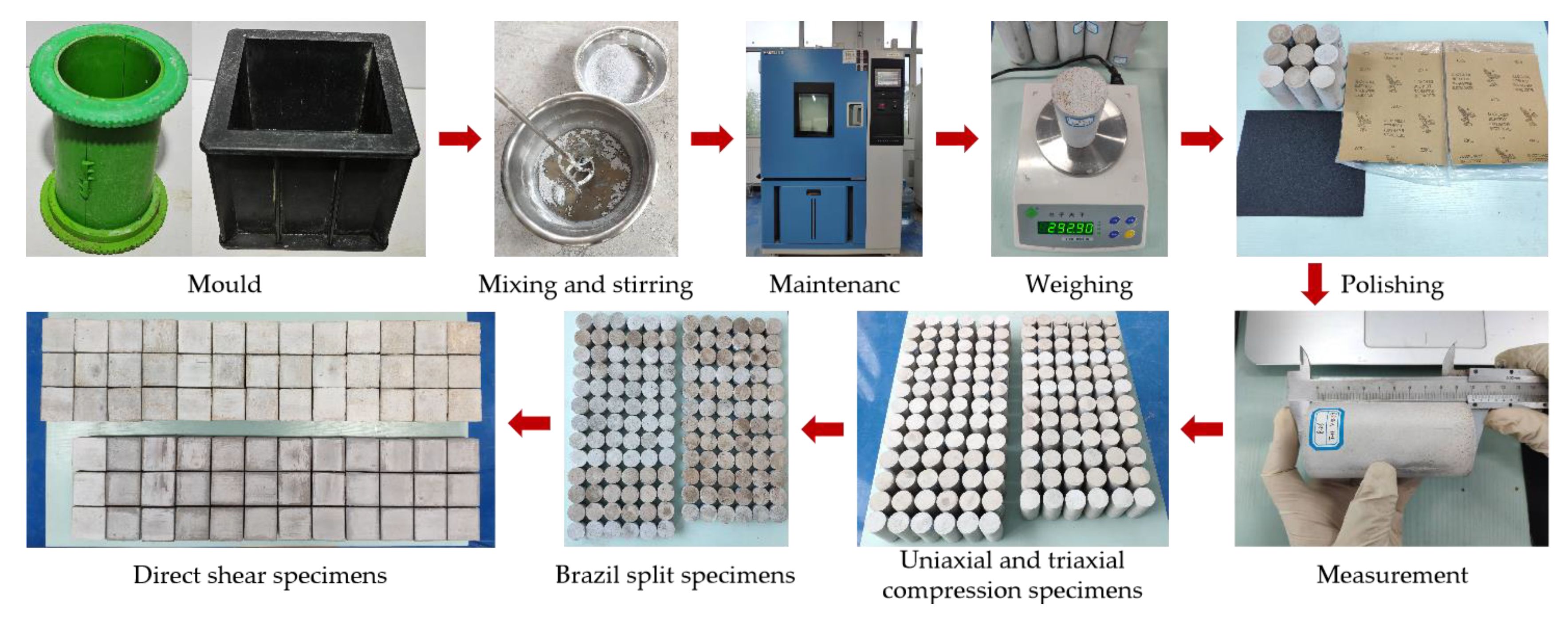
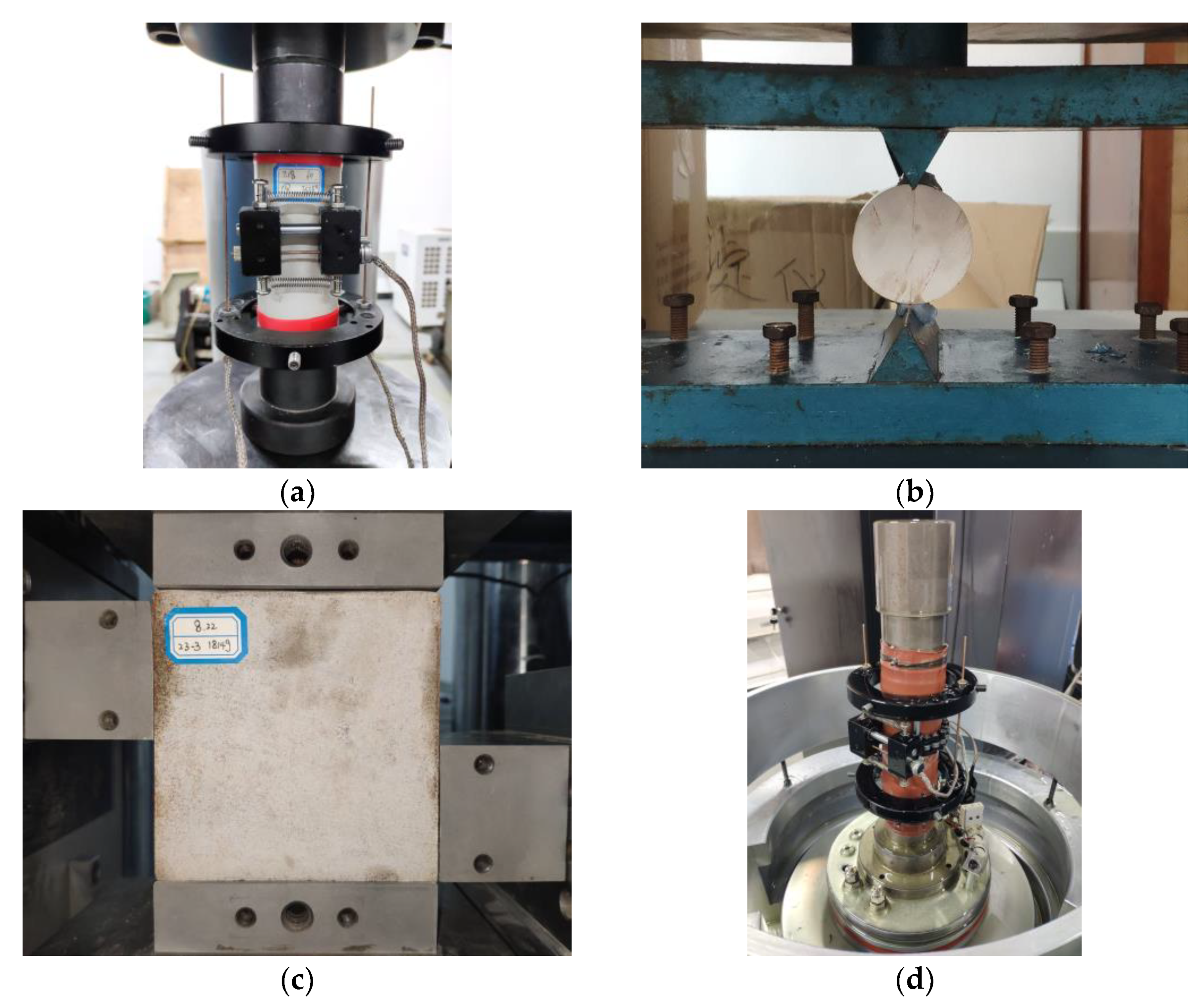


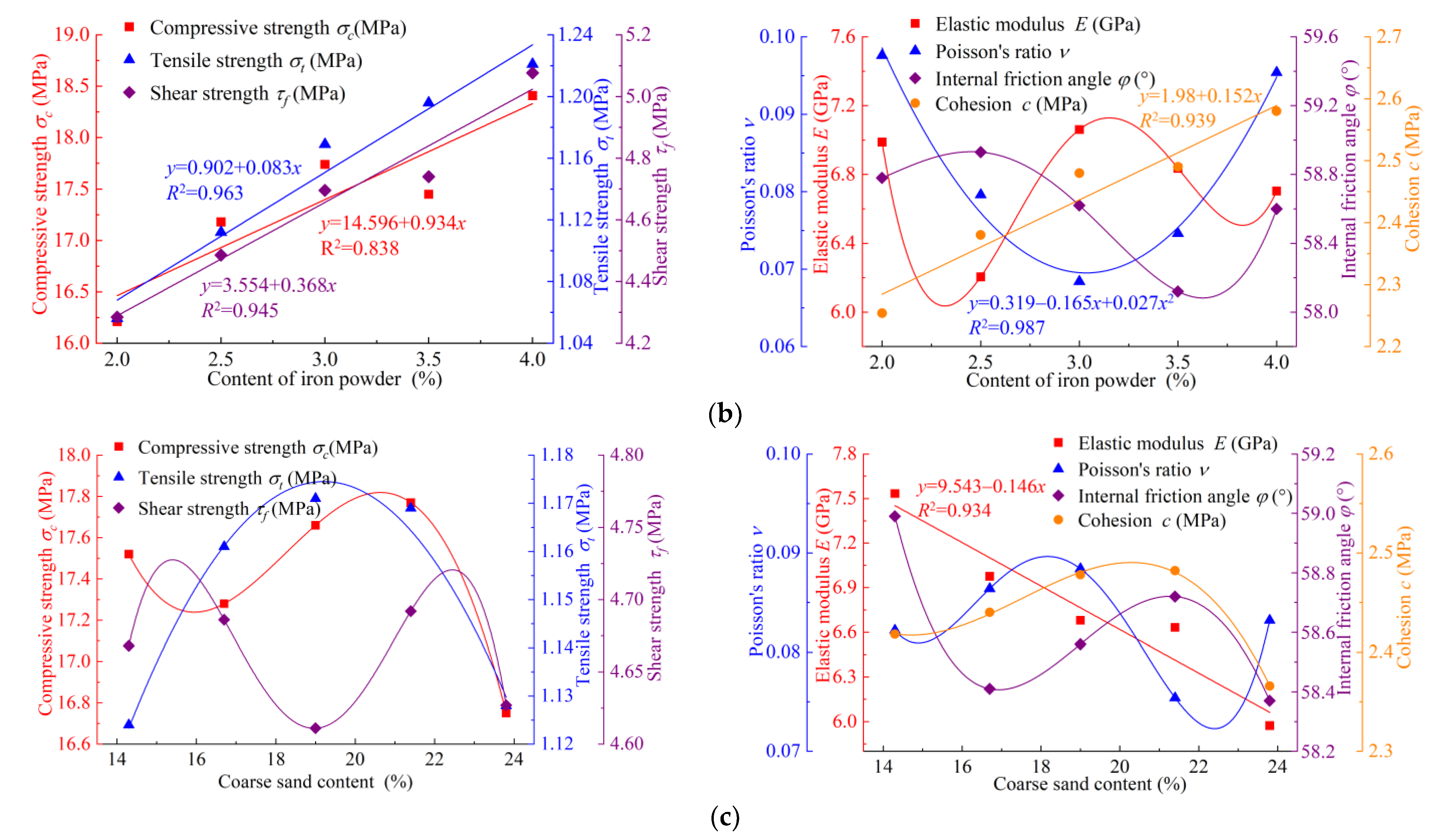
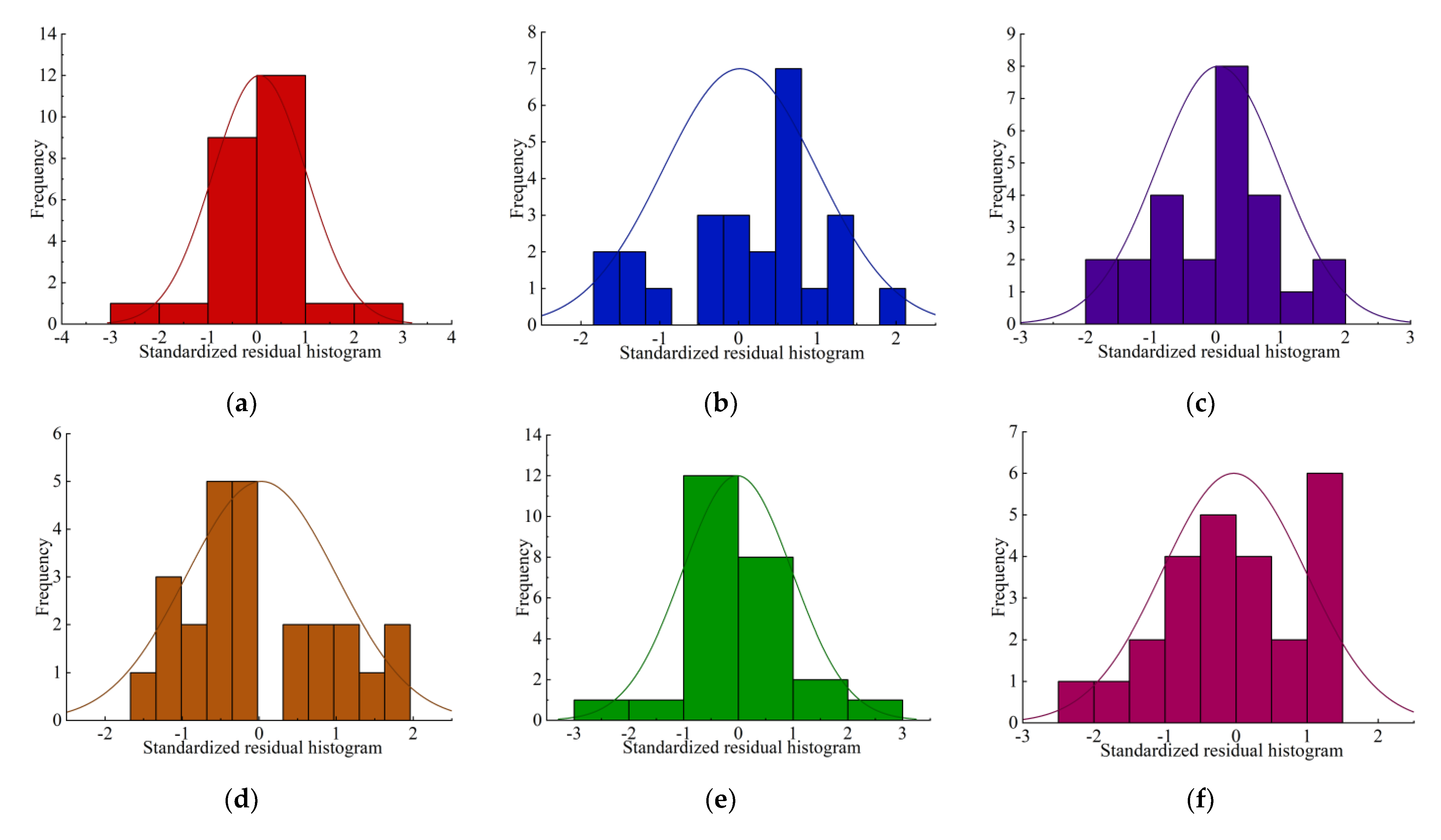
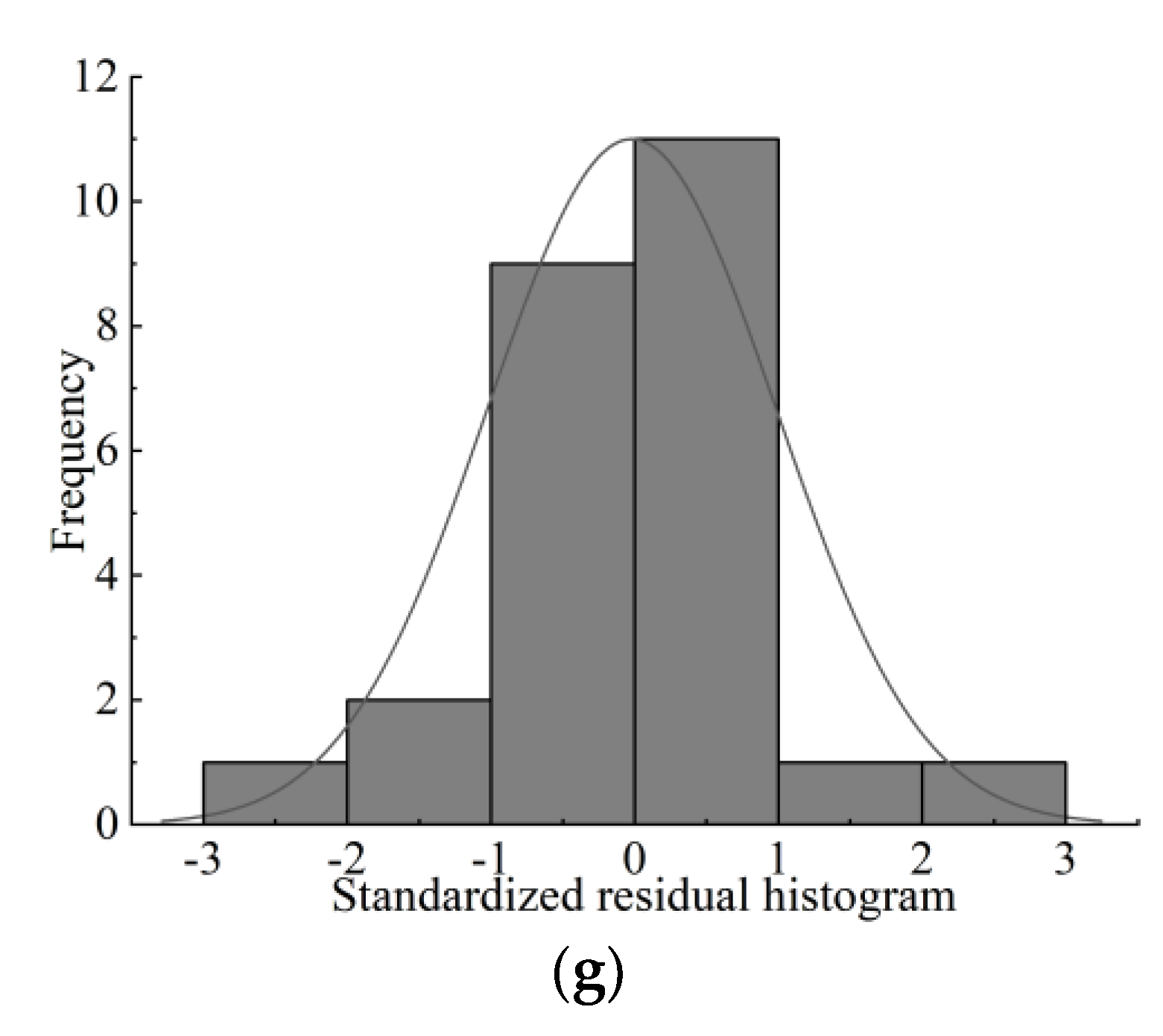
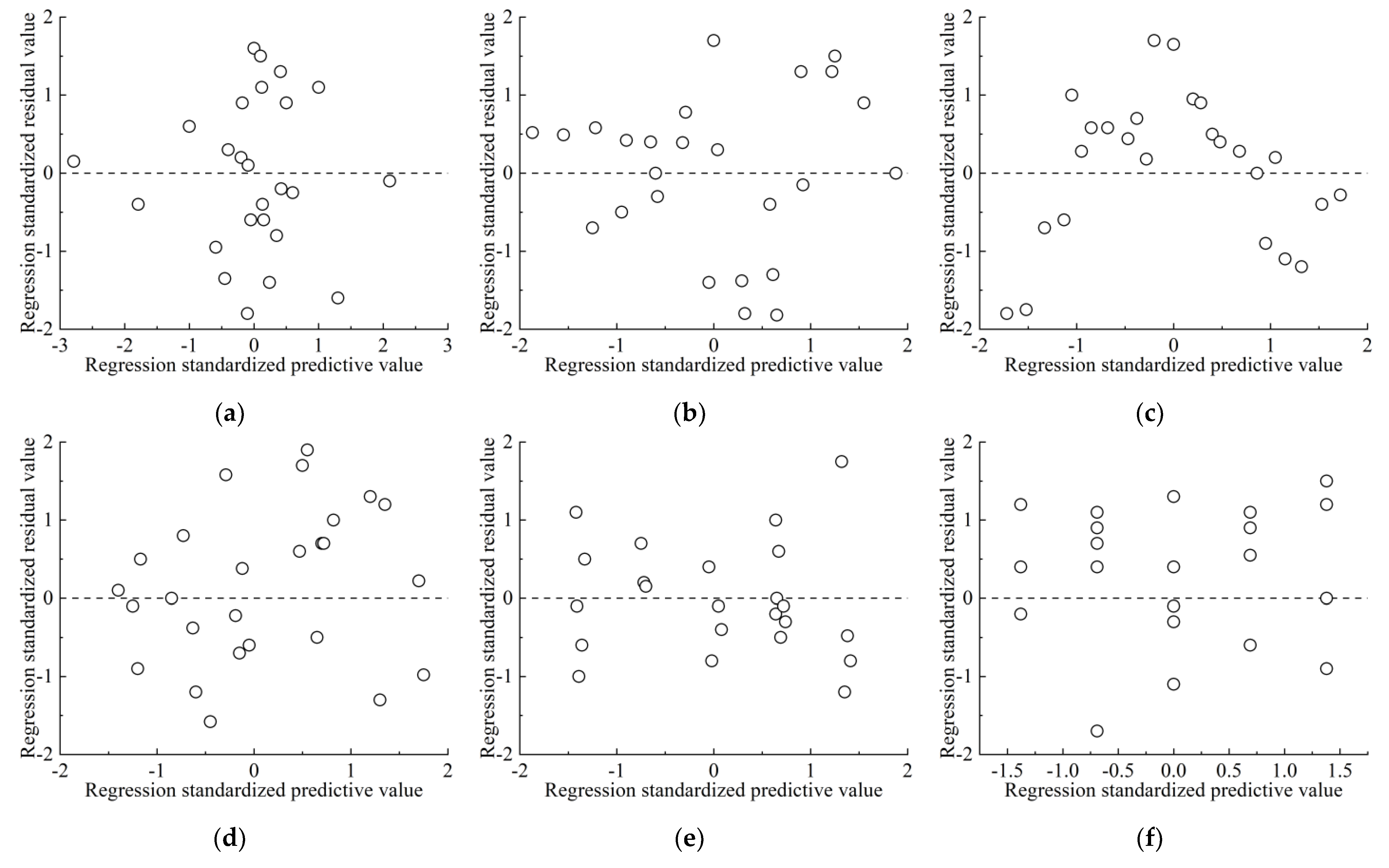
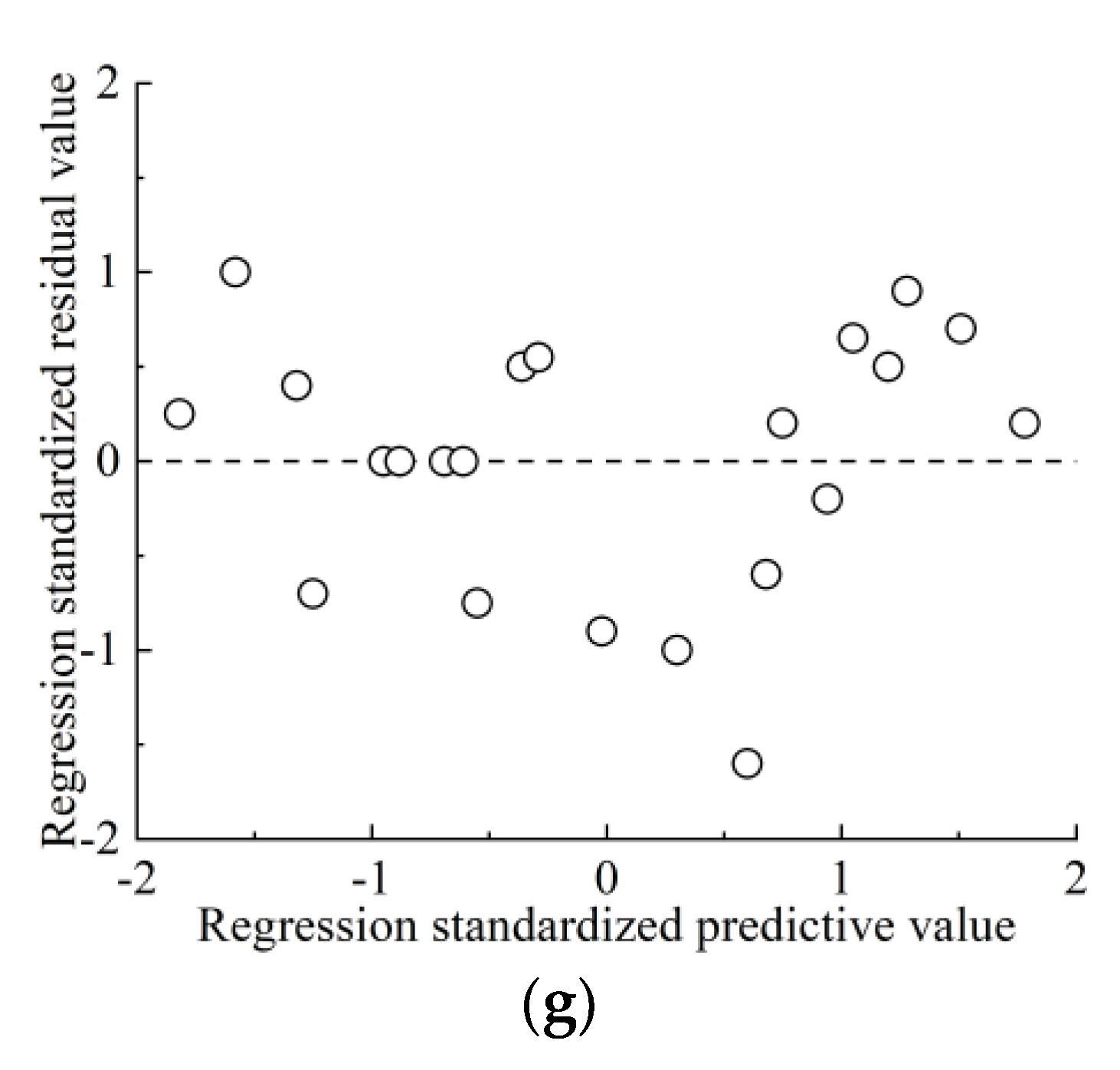
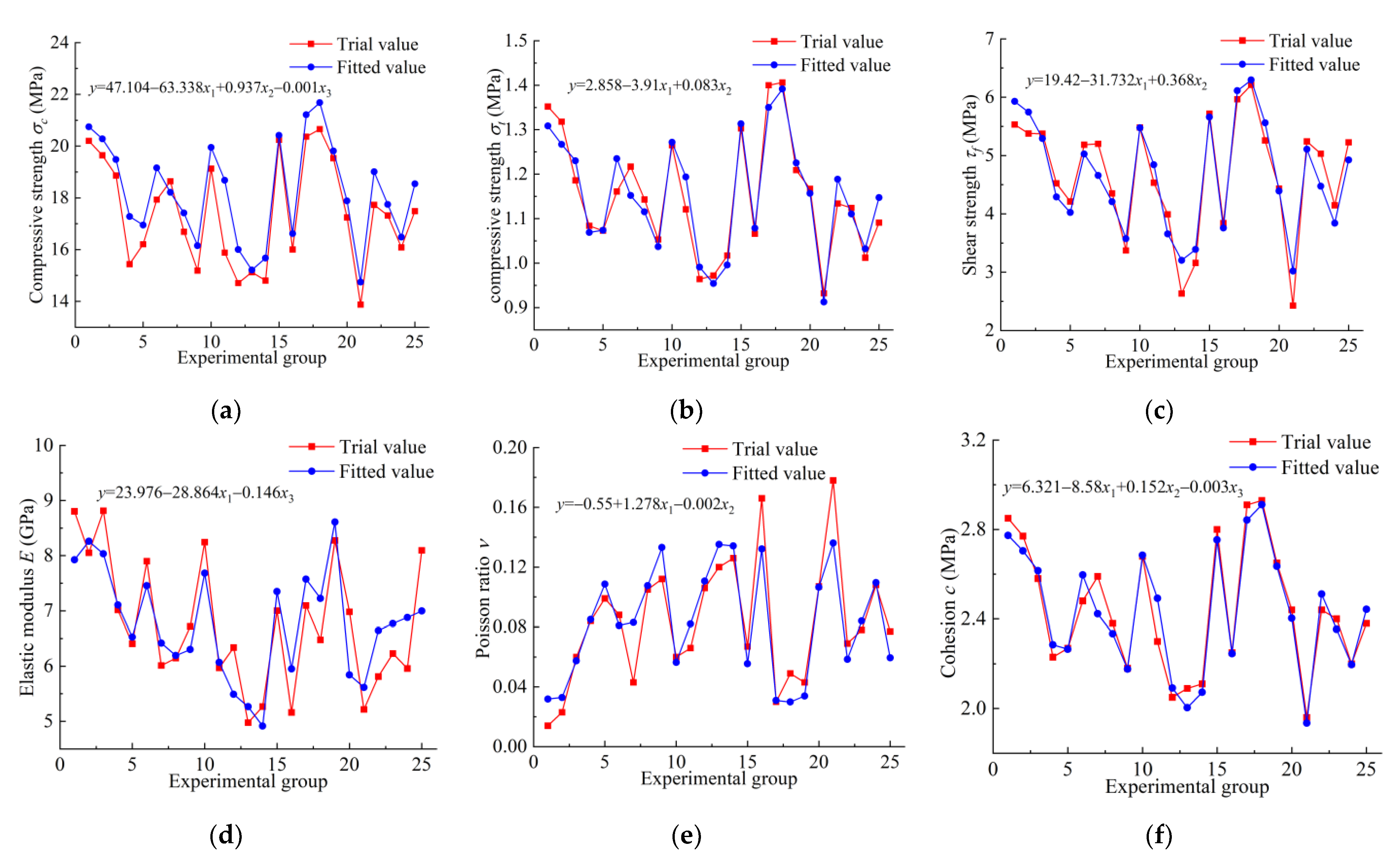
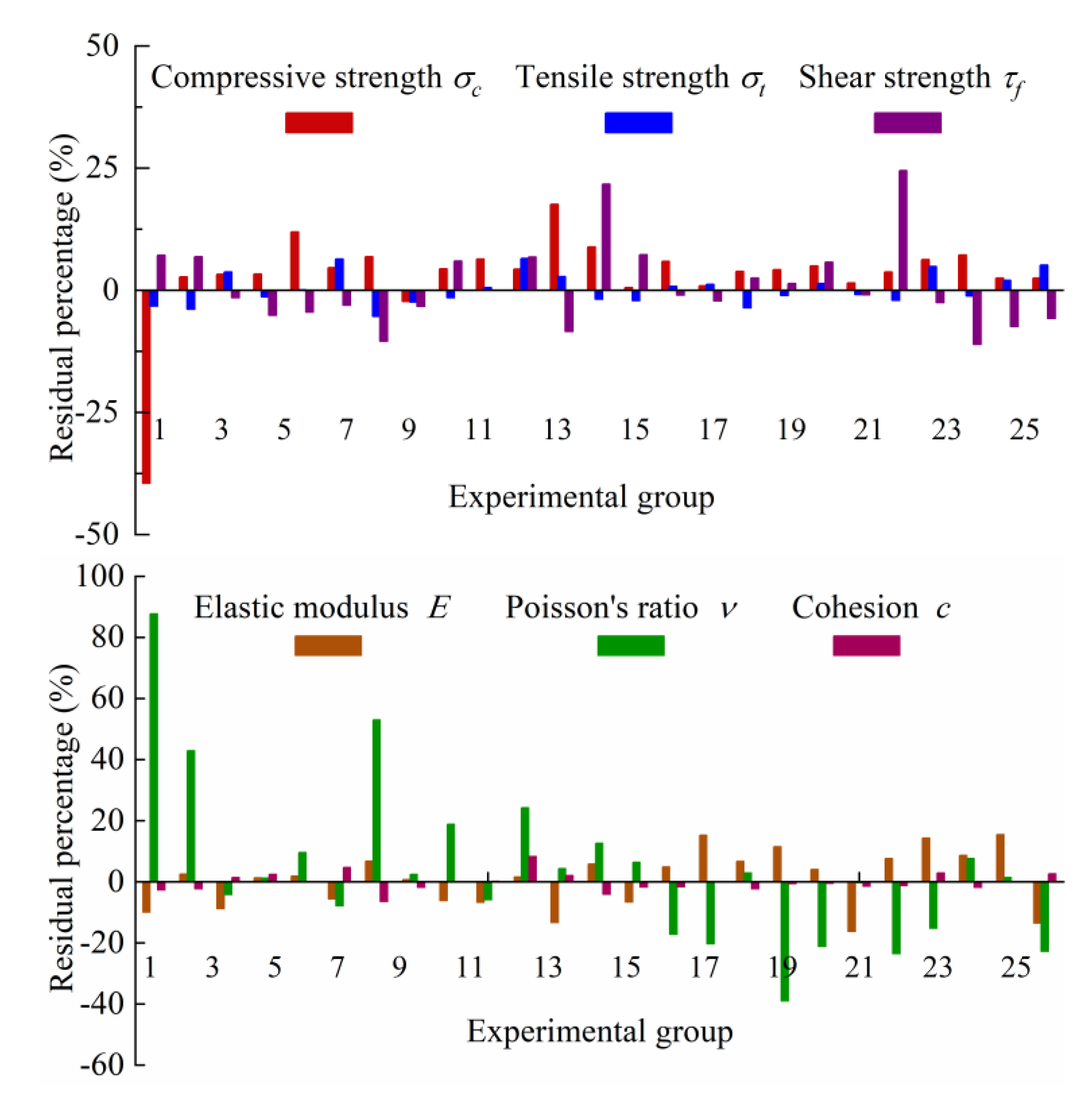
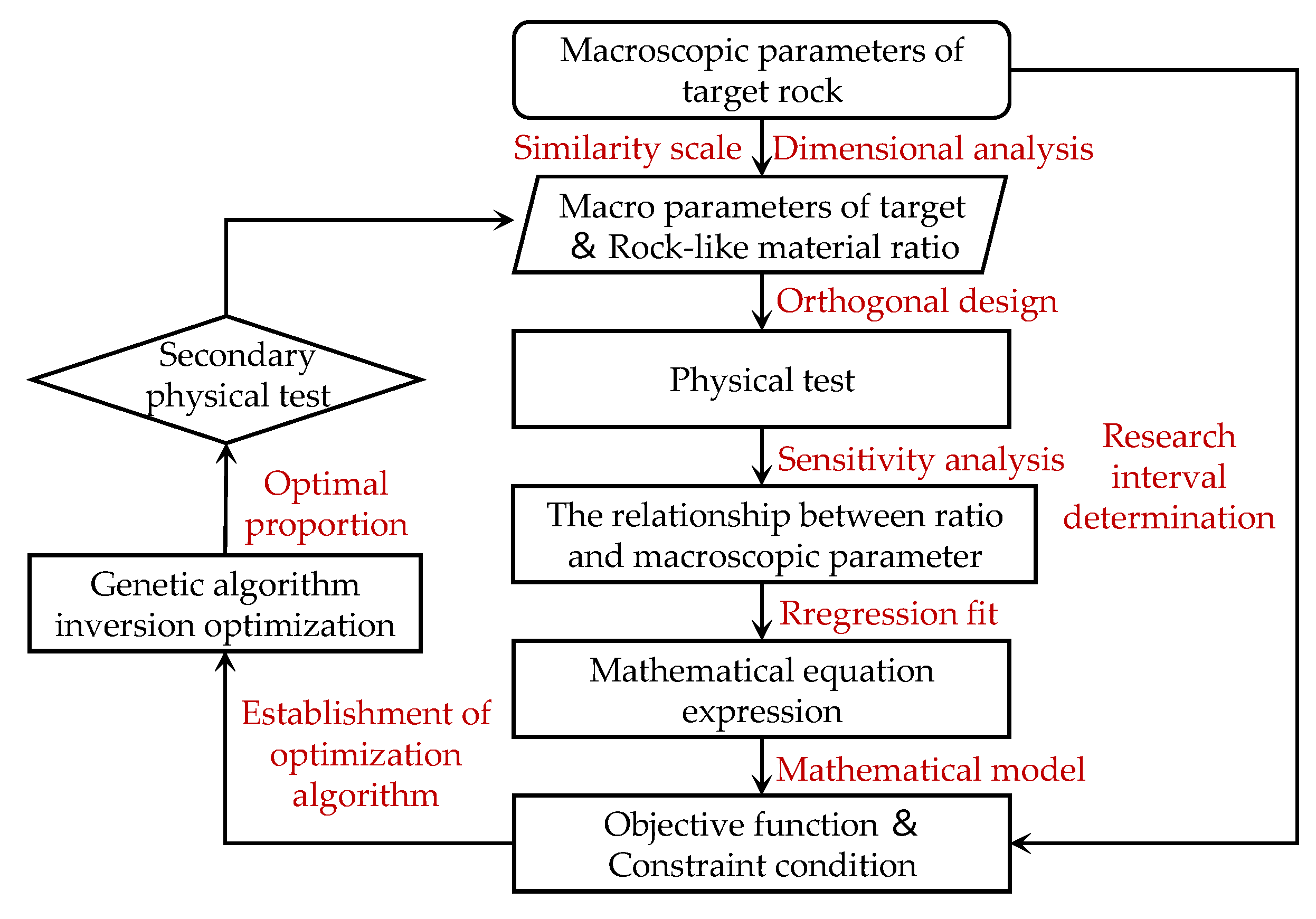


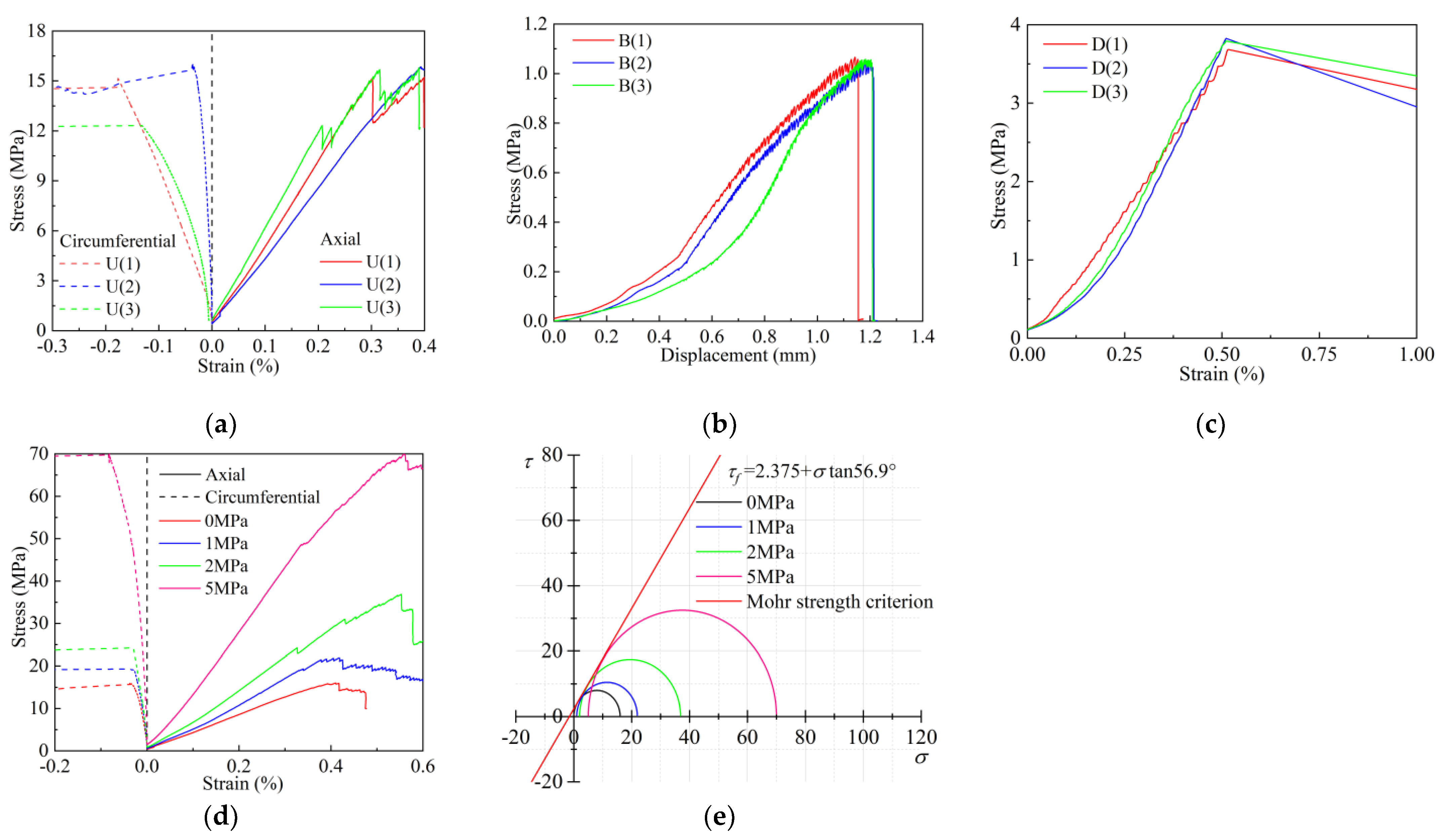
| Physical Quantity | Target Rock | Dimension | Similarity Relation | Similarity Ratio | Target Macro-Parameters |
|---|---|---|---|---|---|
| σc (MPa) | 80 | ML−1T−2 | Sσc = SρS1 | 1:5 | 16 |
| σt (MPa) | 5.33 | ML−1T−2 | Sσt = SρS1 | 1:5 | 1.066 |
| τf (MPa) | 19 | ML−1T−2 | Sτf = SρS1 | 1:5 | 3.8 |
| E (GPa) | 26 | ML−1T−2 | SE = SρS1 | 1:5 | 5.2 |
| ν | 0.15 | - | Sν = 1 | 1:1 | 0.15 |
| φ (°) | 58 | - | Sφ = 1 | 1:1 | 58 |
| c (MPa) | 11.5 | ML−1T−2 | Sc = SρS1 | 1:5 | 2.3 |
| σt/σc | 1/15 | - | Sσt/σc = 1 | 1:1 | 1/15 |
| Rock-like Material Ratio Factors | Water-Gypsum Ratio | Iron Content (%) | Coarse Sand Content (%) |
|---|---|---|---|
| Research interval | 0.46–0.54 | 2–4 | 14.3–23.8 |
| Factor Levels | A | B (%) | C (%) |
|---|---|---|---|
| 1 | 0.46 | 2 | 14.3 |
| 2 | 0.48 | 2.5 | 16.7 |
| 3 | 0.5 | 3 | 19 |
| 4 | 0.52 | 3.5 | 21.4 |
| 5 | 0.54 | 4 | 23.8 |
| Group | A | B (%) | C (%) | σc (MPa) | σt (MPa) | τf (MPa) | E (GPa) | ν | φ (°) | c (MPa) |
|---|---|---|---|---|---|---|---|---|---|---|
| 1 | 0.46 | 3 | 19 | 20.202 | 1.352 | 5.532 | 8.803 | 0.014 | 58.47 | 2.85 |
| 2 | 0.46 | 2.5 | 16.7 | 19.647 | 1.318 | 5.377 | 8.052 | 0.023 | 58.47 | 2.77 |
| 3 | 0.48 | 3 | 14.3 | 18.862 | 1.186 | 5.375 | 8.814 | 0.06 | 59.24 | 2.58 |
| 4 | 0.5 | 2 | 16.7 | 15.436 | 1.084 | 4.523 | 7.016 | 0.084 | 57.80 | 2.23 |
| 5 | 0.52 | 3 | 16.7 | 16.206 | 1.073 | 4.211 | 6.406 | 0.099 | 58.56 | 2.27 |
| 6 | 0.5 | 4 | 14.3 | 17.930 | 1.161 | 5.185 | 7.899 | 0.088 | 58.95 | 2.48 |
| 7 | 0.5 | 3 | 21.4 | 18.639 | 1.217 | 5.201 | 6.013 | 0.043 | 58.76 | 2.59 |
| 8 | 0.52 | 3.5 | 19 | 16.688 | 1.143 | 4.35 | 6.147 | 0.105 | 58.18 | 2.38 |
| 9 | 0.54 | 3.5 | 14.3 | 15.188 | 1.053 | 3.372 | 6.720 | 0.112 | 57.99 | 2.18 |
| 10 | 0.48 | 3.5 | 16.7 | 19.129 | 1.265 | 5.481 | 8.245 | 0.06 | 58.66 | 2.68 |
| 11 | 0.5 | 3.5 | 23.8 | 15.883 | 1.121 | 4.534 | 5.971 | 0.066 | 57.70 | 2.30 |
| 12 | 0.52 | 2 | 23.8 | 14.705 | 0.964 | 3.991 | 6.338 | 0.106 | 58.76 | 2.05 |
| 13 | 0.54 | 2.5 | 21.4 | 15.126 | 0.972 | 2.634 | 4.976 | 0.12 | 59.04 | 2.09 |
| 14 | 0.54 | 3 | 23.8 | 14.801 | 1.017 | 3.159 | 5.267 | 0.126 | 58.09 | 2.11 |
| 15 | 0.48 | 4 | 19 | 20.240 | 1.303 | 5.717 | 7.003 | 0.067 | 58.95 | 2.80 |
| 16 | 0.54 | 4 | 16.7 | 16.003 | 1.066 | 3.84 | 5.162 | 0.166 | 58.56 | 2.25 |
| 17 | 0.46 | 3.5 | 21.4 | 20.364 | 1.400 | 5.965 | 7.096 | 0.03 | 58.09 | 2.91 |
| 18 | 0.46 | 4 | 23.8 | 20.658 | 1.406 | 6.211 | 6.476 | 0.049 | 58.28 | 2.93 |
| 19 | 0.46 | 2 | 14.3 | 19.532 | 1.209 | 5.259 | 8.276 | 0.043 | 59.52 | 2.65 |
| 20 | 0.52 | 4 | 21.4 | 17.241 | 1.167 | 4.434 | 6.980 | 0.107 | 58.28 | 2.44 |
| 21 | 0.54 | 2 | 19 | 13.874 | 0.932 | 2.427 | 5.216 | 0.178 | 58.37 | 1.96 |
| 22 | 0.48 | 2.5 | 23.8 | 17.727 | 1.134 | 5.242 | 5.812 | 0.069 | 59.04 | 2.44 |
| 23 | 0.5 | 2.5 | 19 | 17.316 | 1.124 | 5.030 | 6.229 | 0.078 | 58.85 | 2.40 |
| 24 | 0.52 | 2.5 | 14.3 | 16.086 | 1.012 | 4.147 | 5.958 | 0.108 | 59.24 | 2.20 |
| 25 | 0.48 | 2 | 21.4 | 17.484 | 1.091 | 5.226 | 8.095 | 0.077 | 59.43 | 2.38 |
| Parameter | Significance Analysis | A | B(%) | C(%) |
|---|---|---|---|---|
| σc | F | 86.05 | 13.91 | 3.45 |
| Sig. | <0.001 | 0.009 | 0.042 | |
| Degree | ** | * | (*) | |
| σt | F | 99.13 | 27.75 | 3.21 |
| Sig. | <0.001 | 0.005 | 0.052 | |
| Degree | ** | * | ||
| τf | F | 71.12 | 5.84 | 0.09 |
| Sig. | <0.001 | 0.008 | 0.985 | |
| Degree | ** | * | ||
| E | F | 9.02 | 1.18 | 3.32 |
| Sig. | 0.001 | 0.367 | 0.048 | |
| Degree | ** | (*) | ||
| ν | F | 42.28 | 4.79 | 0.73 |
| Sig. | <0.001 | 0.015 | 0.588 | |
| Degree | ** | (*) | ||
| φ | F | 3.06 | 3.91 | 2.68 |
| Sig. | 0.059 | 0.029 | 0.083 | |
| Degree | (*) | |||
| c | F | 113.54 | 23.84 | 3.36 |
| Sig. | <0.001 | 0.006 | 0.046 | |
| Degree | ** | * | (*) |
| Parameter | 1 | 2 | 3 | 4 | |
|---|---|---|---|---|---|
| σc | Characteristic root | 3.935 | 0.274 | 0.197 | 0.044 |
| Conditional index | 1.000 | 3.925 | 4.832 | 9.424 | |
| σt | Characteristic root | 2.962 | 0.208 | 0.036 | - |
| Conditional index | 1.000 | 4.343 | 9.066 | - | |
| τf | Characteristic root | 2.971 | 0.362 | 0.033 | - |
| Condition index | 1.000 | 2.968 | 9.687 | - | |
| E | Characteristic root | 2.978 | 0.327 | 0.023 | - |
| Condition index | 1.000 | 3.219 | 9.984 | - | |
| ν | Characteristic root | 2.895 | 0.201 | 0.041 | - |
| Condition index | 1.000 | 4.576 | 8.837 | - | |
| φ | Characteristic root | 1.973 | 0.027 | - | - |
| Condition index | 1.000 | 8.602 | - | - | |
| c | Characteristic root | 3.896 | 0.289 | 0.163 | 0.045 |
| Condition index | 1.000 | 3.821 | 5.903 | 9.384 | |
| Parameters | Multiple Linear Regression Equation | R2 |
|---|---|---|
| σc | 0.915 | |
| σt | 0.919 | |
| τf | 0.903 | |
| E | 0.708 | |
| ν | 0.821 | |
| c | 0.934 |
| Rock-like Material Ratio Factors | Water-Gypsum Ratio | Iron Content (%) | Coarse Sand Content (%) |
|---|---|---|---|
| Inverse result | 0.5325 | 3.975 | 15.967 |
| Parameters | Required Value | Secondary Indoor Physical Test (n = 3) | Relative Error (%) | ||
|---|---|---|---|---|---|
| Average Value | Standard Deviation | Coefficient of Variation | |||
| σc (MPa) | 16 | 15.842 | 0.222 | 0.014 | 0.988 |
| σt (MPa) | 1.066 | 1.055 | <0.001 | <0.001 | 1.043 |
| τf (MPa) | 3.8 | 3.777 | 0.005 | 0.001 | 0.609 |
| E (GPa) | 5.2 | 5.128 | 0.585 | 0.114 | 1.385 |
| ν | 0.15 | 0.151 | 0.184 | 1.219 | 0.667 |
| c (MPa) | 2.3 | 2.375 | - | - | 3.158 |
| σt/σc | 1/15 | 1/15.016 | - | - | 0.107 |
Disclaimer/Publisher’s Note: The statements, opinions and data contained in all publications are solely those of the individual author(s) and contributor(s) and not of MDPI and/or the editor(s). MDPI and/or the editor(s) disclaim responsibility for any injury to people or property resulting from any ideas, methods, instructions or products referred to in the content. |
© 2024 by the authors. Licensee MDPI, Basel, Switzerland. This article is an open access article distributed under the terms and conditions of the Creative Commons Attribution (CC BY) license (https://creativecommons.org/licenses/by/4.0/).
Share and Cite
Su, H.; Liu, S.; Hu, B.; Nan, B.; Zhang, X.; Han, X.; Zhang, X. Experimental Study on Proportion Optimization of Rock-like Materials Based on Genetic Algorithm Inversion. Materials 2024, 17, 4940. https://doi.org/10.3390/ma17194940
Su H, Liu S, Hu B, Nan B, Zhang X, Han X, Zhang X. Experimental Study on Proportion Optimization of Rock-like Materials Based on Genetic Algorithm Inversion. Materials. 2024; 17(19):4940. https://doi.org/10.3390/ma17194940
Chicago/Turabian StyleSu, Hui, Shaoxing Liu, Baowen Hu, Bowen Nan, Xin Zhang, Xiaoqing Han, and Xiao Zhang. 2024. "Experimental Study on Proportion Optimization of Rock-like Materials Based on Genetic Algorithm Inversion" Materials 17, no. 19: 4940. https://doi.org/10.3390/ma17194940





